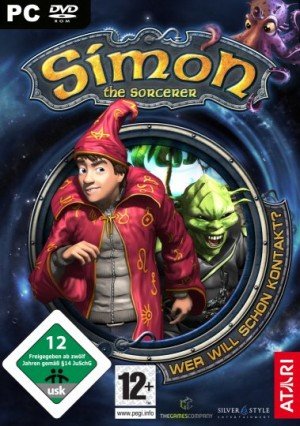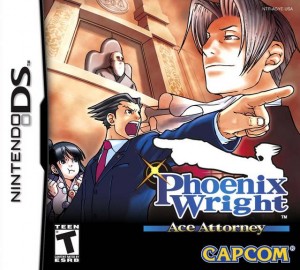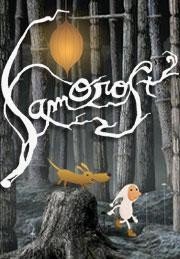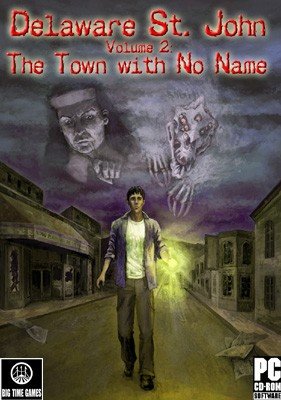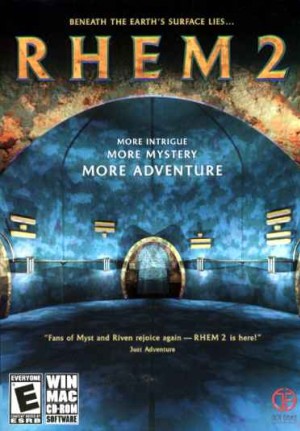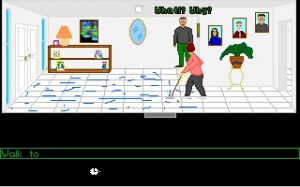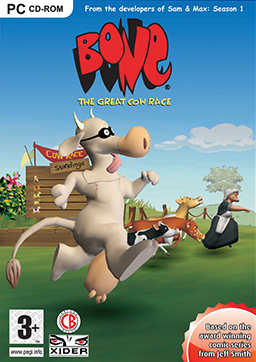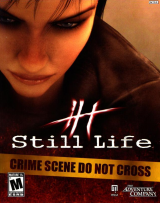Review for Simon the Sorcerer 5: Who’d Even Want Contact?

Of all the surprises Simon the Sorcerer has pulled out of his hat over the years, perhaps the biggest is simply his ability to stick around. As a cheeky British apprentice in the early ‘90s, Simon gained worldwide acclaim for this first two adventures, but the teen’s awkward adolescence was then stunted by ill-fated dabbling in the spells of early 3D, which abused eyeballs everywhere and threatened to kill the series for good. Like many a child actor, for years it seemed that Simon might disappear forever, until suddenly he re-emerged on the scene in Chaos Happens. He hadn’t grown up much after all that time, but he did mellow a bit, return to 2D, and magically morph into an American during his absence. The transition produced some uneven results, but there were signs of promise that the franchise still had a few more tricks in store.
And that’s exactly where his fifth adventure begins in Simon the Sorcerer 5: Who’d Even Want Contact? Simon has settled down for a peaceful life running Calypso’s Magic Shoppe with his girlfriend Alix, still making mischief but finally free of evil wizards and abhorrently civilized doppelgängers. Unluckily for him, that list doesn’t include aliens, and sure enough, little green men toting big, honking laser guns soon invade, intent on taking him prisoner. With a little player ingenuity, not to mention an extendable finger, a lucky bag, and some powder of peacefulness, the crafty Simon manages to escape. But Alix is abducted, the town is besieged, and it’s up to Simon to save both the day and his own butt once again, though not necessarily in that order.
The first thing you’ll notice as you guide Simon around the town square is how gorgeous the game is, complete with scrolling screens and full widescreen support. The same whimsical style remains, but gone is the slick CGI-looking technical presentation of the last game, cleverly replaced here by cel-shaded cartoons, making it feel more like a true series descendent. The background detail is impressive, from the tightly-cobbled stone walkway to slatted rooftops to roaming ivy climbing the walls, and the character models are equally attractive. They’re perhaps a bit angular and heavy on shadows during close-ups, but they appear perfectly natural in the environments and are fluidly animated.
In fact, animation is perhaps the high point of Simon 5. There is no skimping in this oft-shortchanged area, as every little action results in a polished onscreen enactment, and each location has ambient effects that nicely bring the environments to life. If Simon can’t reach something, you’ll see him valiantly leap several times until he grabs it, before smoothly stuffing it into his hat even as an alien spacecraft patrolling overhead casts its shadowy spectre over the smoking wreckage it’s caused. To round out the visual treat, a generous helping of cinematics are also layered in using the same game engine for seamless integration. Whether it’s Simon diving into a disgusting mound of garbage with pursuers hot on his tail, a teleport beam that would do the Enterprise proud, or our hero getting hoofed in the nether regions (hey, I said it looks good, not that it wasn’t painful to watch), there’s always some new cutscene ready to spice things up graphically. There are even a few “thought bubble” animations added just for laughs.
Unfortunately, that may be just about the only time you will laugh. Apart from the odd laudable sight gag, Simon 5 just isn’t very funny. It’s not anti-funny in that “groan at a bad punch line” sort of way, but the dialogue just never really hits any high comedic notes. Instead, it generally settles for lighthearted silliness, producing goofy grins rather than thigh-slapping hilarity. The game pokes occasional fun at itself, and it includes nods to many pop culture references, including Pirates of the Caribbean, Men in Black, Hitchhiker’s Guide to the Galaxy, and Shrek, though these are more for background colour than actual yuks. There’s an inherent playful charm in this approach, but you’ll need to lower your expectations accordingly. As Simon himself acknowledges at one point, “Okay, okay, I’ve been funnier before." He’s right.
Unlike some of the earlier games, Simon is pretty mild-mannered here. He’s quick with the quip, but usually not insulting towards others. Optional dialogue choices do let you ramp up the smart-alec quotient if you want, but even the most barbed repartee still comes across as fairly harmless banter. The same can’t be said of Red Riding Hood, an absolutely atrocious returnee from the last game. The “fanatic feministic snotty brat” is back in full venom, still spouting unprovoked women’s lib hostilities at length for no apparent reason. The concept is fine, but here it’s beaten into the ground, entirely gratuitous, and isn’t ever amusing. The fact that it comes from what looks like a ten year old girl with the voice of a raspy-throated adult, even dropping in an F-bomb that somehow escaped the censors (which isn’t true of the bleeped-out subtitles), isn’t endearing, it’s obnoxious. The developers seem to think she’s humourous. They’re wrong.
None of the other characters are nearly as annoying as Red Riding Hood, thank goodness, although few are very memorable. Still absent from the glory days are the likes of Sordid, Runt, and the woodworms, but back once again is the sultry Goldilocks, still up to her thieving ways but drastically underused, the Swampling, still making barf-inducing (literally) soup and desperate for friends, and the hard-drinking Wolf, who gets off the sauce long enough to expand his role here as a playable character for a short time. Also back (for those who can remember that long ago) from Simon 2 is a genie now acting as a Freudian psychoanalyst, though his role here is fairly understated. New additions include the likes of a flamboyantly gay ship captain, a race of secret agent mole people, and of course the alien Nihonians, who are more than simple tourists in this particular adventure.
Much to the chagrin of original Simon fans, he’s still American here and played by the same voice actor as the last game. It’s not the dealbreaker for me that it is for some, though it’s a curious choice since Chaos Happens never even got a North American release. Catering to an audience who may not even play the games seems to defy logic, though this isn’t the only time logic is abandoned in Simon 5. In any case, the lead voiceover is acceptable, if clearly performed by non-native speaker, sounding rather stilted and formal with odd intonation at times. Other performances exhibit the same general quality and the same minor problems, along with some poor direction resulting in unnatural inflections or emphases. The whiny, pre-pubescent Swampling is as irritating as ever, but I think by now that’s understood to be intentional. A mechanical parrot is almost as annoying, however, so perhaps it’s time to rethink the “so bad it’s supposed to be good” theory. I was about to slam one particular voice for being the biggest offender of all, but I can’t bring myself to come down too hard on a sock puppet. The best roles are a computerized voice, a depressed battle robot, and the aliens themselves, perhaps not surprisingly, as any vocal peculiarities are integral to the delivery.
The rest of the audio is fairly well done, with a nice range of sound effects and a pleasant soundtrack, though the music never seems to really mesh thematically with the locations. That’s fairly significant, since unlike other Simon games, here you’ll be travelling to a very disparate set of locales. You’ll soon say goodbye to familiar fantasy trappings as you wind up on a tropical beach with a group of stranded pirates (what game doesn’t have those these days?), then tunneling down into a mysterious Mole City before taking flight in your patchwork spaceship en route to the Death Sta… I mean, the alien capital Eye of Death. I appreciated the diversity, particularly as it let the artists have fun designing such vastly different worlds, though if you’re wondering what many of these settings have to do with Simon the Sorcerer, you won’t be alone.
The story is predictably absurd but fairly straightforward, existing mainly to present one wacky obstacle after another. In order to reach Alix in space and wreak havoc on the Nihonians, Simon-style, you’ll first need to find a way to get there. Naturally, when thousands of miles and the most motley crew ever disassembled stands between you and your goal, the most important thing to do is: collect stuff. The vast majority of Simon 5’s puzzles are inventory-based, and you’ll gather plenty of bizarre items in your travels, from chocolate sensors to talking hammers to thirsty leeches. Thankfully, your magic hat is bottomless, though you’ll have to make do without for a while, juggling only what you can carry until Simon finds a functional (if not nearly as fashionable) replacement.
The game does include a few other puzzle types, which are rare but welcome when they appear. There’s a sequencing riddle to decipher and a handful of multiple-choice dialogue puzzles to navigate, and at one point there’s even a Fate of Atlantis-style choice of three puzzle paths to choose from. Unlike Indiana Jones, Simon’s decision only affects a five or ten minute stretch of gameplay, but it’s an admirable inclusion, and I saved my game before choosing and explored all three just for kicks. Late in the game, when taking over as Wolf, you’ll encounter a bizarre Yoda-like sequence where you learn some mental powers. It’s a good idea, though it’s only used briefly and is ultimately just another form of inventory puzzle, except with skills instead of items.
Many of the puzzles are adequately clued, and if taken with a grain of “comic adventure” salt, the solutions make a reasonable degree of sense. There are some that fall prey to backwards-logic syndrome, however, requiring trial and error, random item combinations, and a bit too much hoop-jumping to pin down the designers’ specific thought process. And while you usually have multiple goals at any one time, often you’re forced to solve them in a strictly linear order, and there’s no way of knowing what’s a priority ahead of time. Nevertheless, the bulk of the gameplay is pretty traditional adventuring fun that shouldn’t stump you for long.
If you do get stuck, you can always turn to the game’s hint system, though its helpfulness can vary wildly. By opening up your “quest log”, you can see your current objectives and click on three levels of hints. The first typically just establishes your goal, the second offers a nudge-wink observation, and the third… well, the third is all over the place. Sometimes it spells out a solution in detail, sometimes it assumes you know things you don’t. The two times I most needed guidance, I clicked all three levels of hints and found nothing of use to me. In one case, it’s because I hadn’t found a lone tiny item that had miraculously appeared in a totally arbitrary place. There are a few pixel hunting moments in Simon 5, but those are easily overcome with a handy hotspot highlighter (the “G” key for those without a manual) which reveals all collectable items on screen. Not every item, mind you, as there are plenty of interactive objects you can check out besides the ones you’ll need.
Interacting with the environment is a basic point-and-click affair. You could play the entire game with just the left mouse button, though right-clicking provides optional observations of usable objects. Movement is just as intuitive, as a click close by will make Simon walk to that point, while clicking a distant area will cause him automatically to run. This idea is so elegantly simple that all games should use it, though I lost track of how often I double-clicked anyway, just out of habit. The inventory is quickly accessed by sweeping over a hidden bar at the bottom, and full dialogue choices are easily selected from a list, though unfortunately there’s no way to repeat them if so desired.
After a fairly relaxed pace throughout, the game really takes off, in more ways than one, when Simon finally blasts into orbit. That’s not a particularly good thing, however. While giving the game a more epic scope, with the fate of the entire world hanging in the balance of Simon’s mediation skills (heaven help us all), it careens towards a final confrontation so fast and furiously that it makes little sense. New characters are abruptly introduced simply as plot devices (and then dropped), Wolf’s sudden rise to prominence comes completely out of the blue, and a major plot twist is unveiled apparently just because it could be. I know Simon the Sorcerer and reality don’t go hand in hand, but too much weirdness all at once is confusing and unnecessary. It’s as if the designers realized they were approaching the end and had to quickly cram in the rest. Too bad they didn’t feel the same urgency to cut off the credits, which run on interminably long with a series of blank-screen, yawn-inducing narrations.
If the final landing is a little rough, at least the flight itself is a fairly fun ride. A subtitle like Who’d Even Want Contact? practically begs for jokes at the game’s expense, but this is actually a pleasant little adventure. It’s never particularly funny, its characters are largely forgettable, and the puzzles are hit-and-miss. But it’s breezy, it’s cheerful, and lovely to look at, with a distinct charm that eases you through any turbulence. Currently available only through digital distribution at GamersGate, it’s more Saturday morning than Sunday evening cartoon (some slightly racy content aside), but with roughly ten hours of gameplay all told, you could start at the former and end at the latter, and have an enjoyable weekend of Simon the Sorcerer 5 in between.


